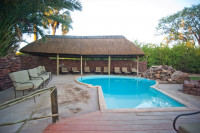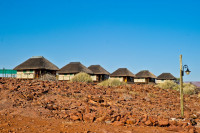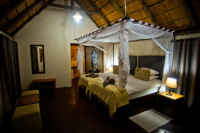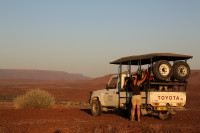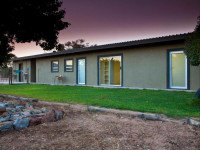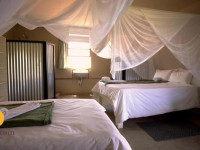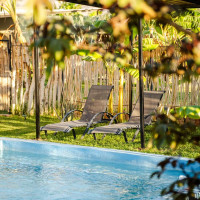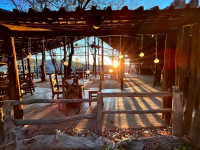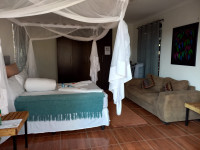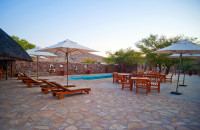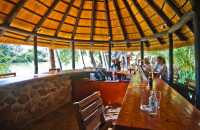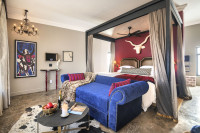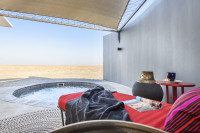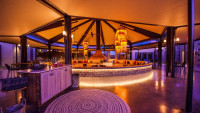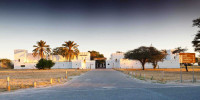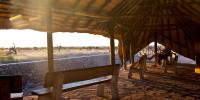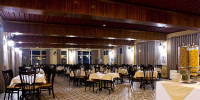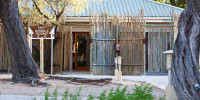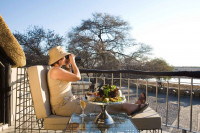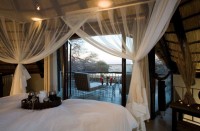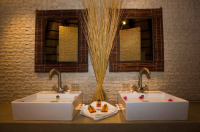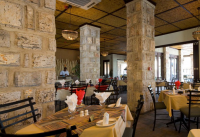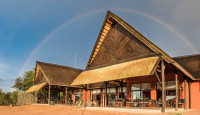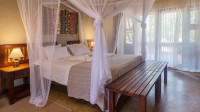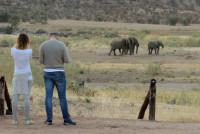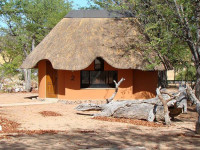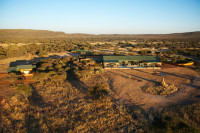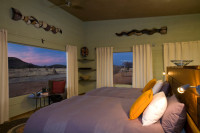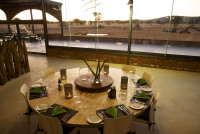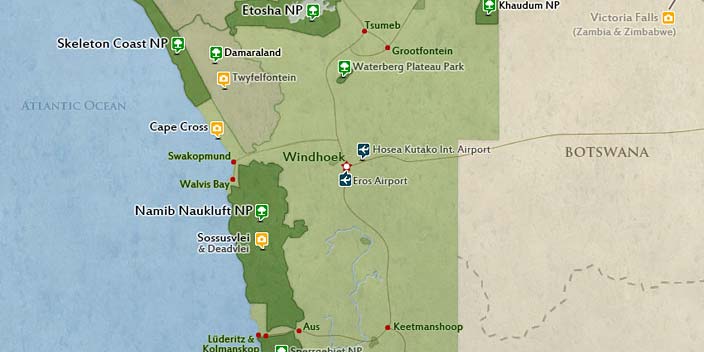
$14,850 pp (USD)
2 travelers on Start dateArrival
Arrival

Day 1-2
Namib Desert- Sossusvlei
Namib Desert- Sossusvlei
Your guide will pick you up from the airport or your accommodation in Windhoek and drive straight to Sossusvlei. You will drive southwards to the desert through scenic landscapes that may include mountain passes, depending on the road being used. You will have a lunch stop along the way to Sossusvlei. After checking in and relaxing, you will head into Sossusvlei for a late afternoon game drive in the Namib-Naukluft Park. You will explore some of the oldest and highest sand dunes in the world in Sossusvlei on the second day. You will visit the Dead Vlei, which is a white clay pan with dry Camel Thorn trees that are believed to have been dead for 800 years. Depending on your energy levels, one may climb the Big Daddy dune, which is estimated to be 325 meters. You will visit the Sesriem Canyon, which is about a kilometer long and 30 (100ft) meters deep.
- Main Destination:
- Sossusvlei (Sand Dunes)
- Accommodation:
- Le Mirage Resort & Spa
- Meals & Drinks:

Day 3-4
The Namibian Atlantic Coast
The Namibian Atlantic Coast
An early morning will take you up in the sky with a hot air balloon. You'll experience Sossusvlei from above the sky. You will have a champagne breakfast in the sand dunes. You will then drive to Swakopmund past scenic passes and a bird sanctuary with chances of seeing hundreds of flamingoes and other water birds. The following day, you will embark on a Welwitschia drive. This drive is renowned for its unique flora, most notably the endemic Welwitschia mirabilis, which is exclusive to the Namib desert regions of Namibia and Angola. This scenic route unveils the mesmerizing moon-like expanse of the Moon Landscape. After lunch, you will proceed to the Sandwich Harbour, on an adventure 4 x 4 sand dune driving. This is where the dunes meet the sea. The coastal desert environment is characterized by pale sand dunes with traces of black shades of magnetite, implying they are of greater aesthetic value, as well as being a photographer’s playground.
- Main Destination:
- Swakopmund (City)
- Accommodation:
- Swakopmund Luxury Suites
- Meals & Drinks:

Day 5-6
Palmwag via Skeleton Coast National Park
Palmwag via Skeleton Coast National Park
You will continue northwards along the coast past the largest seal colony in the world into the less visited Skeleton Coast National Park, which is renowned for its cold and unpredictable Benguela Current of the Atlantic Ocean that contends with the dune and desert landscape. Wildlife here includes oryx, springbok, black-backed jackal, ostrich, brown hyena, desert-adapted elephant, black rhino, and lion. Because of the harshness of the area, these animals do not occur in huge numbers and are not very easily spotted, so let’s keep our eyes peeled. On the second day at Palmwag Concession, you will head out in search of the desert-adapted black rhino. You will be taken by local guides and Rhino Rangers. The Namib Desert is home to the last truly wild stronghold of black rhino. This activity involves 4 x 4 driving in a rugged terrain, and a walking safari to get to the rhinos if lucky. These mammals are not in a fenced area but in an open ecosystem.
- Main Destination:
- Palmwag Concession (Damaraland)
- Accommodation:
- Palmwag Lodge
- Meals & Drinks:
Day 7-8
Hoanib River Expedition
Hoanib River Expedition
After breakfast, you will head towards the Hoanib River. You will explore the Hoanib River, which is 270km long and one of the 12 ephemeral rivers in Namibia less visited by tourists. Amazingly, it is rich in desert flora and fauna, though sparsely
populated. You will explore the area in search of desert-adapted elephants if not encountered around the Palmwag area. You'll enjoy your lunch packs under one of the big Winter Thorn trees in the riverbed before checking in at our lodge. On the second day, you'll spend the day exploring the Hoanib River with local guides. With approximately 120 of their kind left, desert-adapted lions are a rare group of carnivores that have adapted to survive in one of the harshest, most unforgiving landscapes on earth. With numbers dwindling as human encroachment threatens their future, sightings are few. However, with luck, one might see them. There are desert-adapted elephants, oryx, steenbok, springbok, black-backed jackals, among others.
- Main Destination:
- Sesfontein (Town)
- Accommodation:
- Sesfontein Guesthouse
- Meals & Drinks:
Day 9
Wild West Namibia-Kaokoland
Wild West Namibia-Kaokoland
After breakfast, you will visit the OvaHimba tribe and learn their fascinating culture and way of life. They are semi-nomadic pastoralists with huge herds of cattle. You will learn about the intriguing traditional life of the OvaHimba tribe, including their dress, food, and craft. You will also learn about how the homestead is built, with holy fire at its heart (where all communication with ancestors takes place). They are not there for tourism only; Kaokoland is their home. As you drive to our destination, you will meet them as they go about their normal day chores.
- Main Destination:
- Opuwo (Town)
- Accommodation:
- Kaoko Mopane Lodge
- Meals & Drinks:

Day 10
Wild West Namibia- Epupa Falls
Wild West Namibia- Epupa Falls
After a relaxed morning, you will make your way to Epupa Falls past the OvaHimba tribe villages. Once again, it is great to see them going about their normal day-to-day chores. During late afternoon, you'll take a sundowner drive with the local guide to the Epupa Falls and enjoy your drinks at the falls. The border river between Namibia and Angola, the Kunene, plummets down a 40-meter-deep gorge at the Epupa Falls. The river is about 0.5 kilometers (1,600 ft) wide in this area and drops in a series of waterfalls across a length of 1.5 kilometers (0.93 mi), with the greatest single drop being 37 meters (121 ft).
- Main Destination:
- Epupa Falls (Kaokoland)
- Accommodation:
- Omarunga Epupa-Falls Camp
- Meals & Drinks:

Day 11
Wild West- Kunene River
Wild West- Kunene River
You'll have a much more relaxed day today as your drive to Kunene River Lodge is not very long. You will start your day with a birding walk and continue driving along the Kunene River. Nested in huge Makalani Palm trees, enjoy the beauty,
peace, and tranquility of this riverine habitat. You will arrive at lunch and embark on an afternoon boat cruise with the hope of seeing rare birds like the Cinderella Waxbill, Grey Kestrel, and Angolan Cave Chat, among others. This is the only camping day along the Kunene River.
- Main Destination:
- Ruacana Falls (Highlight)
- Accommodation:
- Budget camping
- Meals & Drinks:

Day 12
Etosha National Park- North
Etosha National Park- North
This is a driving day. After breakfast, you will continue exploring the Kunene River past a hydroelectric dam towards the small town of Ruacana. You will drive past a series of towns to get to our destination, Etosha North. These northern parts of Namibia are the opposite of Kaokoland, as they are heavily populated. You will stop for lunch along the way. You'll get to experience the land of the Owambo people, which has a total surface area of around 56 000km2. The land consists mainly of communal farming land, and most of the inhabitants survive on subsistence farming. Various wetlands host several water birds.
- Main Destination:
- Eastern Etosha National Park
- Accommodation:
- Etosha King Nehale
- Meals & Drinks:

Day 13-14
Etosha National Park- East
Etosha National Park- East
This morning, you will explore the less-visited part of Etosha, the northern area around Andoni Plains, and make your way to the eastern part of the park. This part of the park has an open grassland and dense vegetation. Giraffes seem incongruent being a tree browser, and there are no trees around for kilometers. Their size contrasted with the openness of the plains, making an interesting, if lonely, photo. On the second day, you will have more of a relaxed day of morning and afternoon game drives in the eastern part of Etosha. Besides the 114 mammals found here, 340 bird species are known to occur in Etosha National Park. About a third are migratory, including the European Bee-eater, and several species of waders. Ten of Etosha’s 35 raptor species are migratory. Those mostly commonly seen are the lappet-faced vulture, the white-backed vulture, the hooded vulture, and on very rare occasions, Cape, Egyptian, and palm-nut Vultures have been recorded. 8 species of owls have been recorded.
- Main Destination:
- Eastern Etosha National Park
- Accommodation:
- Namutoni Resort
- Meals & Drinks:

Day 15-16
Etosha National Park- South
Etosha National Park- South
You'll have a full day game drive in our vehicle. This includes a lunch stop somewhere in the park. This park is semi-arid, hence animals depend on contact springs, water level springs, artesian springs, and a couple of man-made waterholes for water. You will be visiting these waterholes all day long as you drive from the eastern to the southern past the central part of the park. On the second day, you'll explore the southern part of the park. It is much drier compared to the northern and eastern parts.
- Main Destination:
- Etosha National Park
- Accommodation:
- Okaukuejo Resort
- Meals & Drinks:
Day 17-18
Western Etosha- Hobatere Concession
Western Etosha- Hobatere Concession
After breakfast, you will continue your journey westwards to explore another less-visited western part of the park. This is a full-day game drive. You will exit the Etosha National Park at the western gate to access the Hobatere Concession. Hobatere is outside the park on the western side and belongs to #Khoadi//Hoas Conservancy. Covering an area of 8,808 hectares, its primary objective is to increase the benefits to the local community, reduce human-wildlife conflict, and also conservation of the area. On the second day, you will have a morning game drive around the concession with local guides. You will learn more about the plant and birdlife, and admire the amazing termite mound structures among big mopane trees. If lucky, you might even spot a herd of elephants or a local pride of lions. After dinner, you will go for a night drive. With luck, you might encounter nocturnal animals like Aardvark, Cape Fox, Bat-eared Fox, Aardwolf, Small Spotted Genet, among others.
- Main Destination:
- Western Etosha National Park
- Accommodation:
- Hobatere Lodge
- Meals & Drinks:

Day 19-20
AfriCat Foundation-Okonjima Private Nature Reserve
AfriCat Foundation-Okonjima Private Nature Reserve
After an early morning start, you will make your way to Okonjima Nature Reserve, which is the home to the AfriCat Foundation. Founded in 1993, the AfriCat Foundation is primarily dedicated to the conservation of large carnivores. The Foundation lies on a 22000-hectare Reserve. In the afternoon, you will embark on a leopard tracking activity. This closed ecosystem is renowned for having the highest density of leopards in Namibia. They have a couple that are collared with a VHF collar. Using telemetry, the guides usually locate these wild leopards, hence the chances are high of encountering one. On the second day, you will embark on a white rhino tracking on foot. In the afternoon, you will visit the Africat center to learn more about Namibia’s carnivores and their fight for survival and the Human-Wildlife Conflict challenges that face both man and carnivore. AfriCat creates conservation awareness through environmental education and conducts constructive wildlife research.
- Main Destination:
- Okonjima Private Nature Reserve
- Accommodation:
- Okonjima Plains Camp
- Meals & Drinks:

Day 21
Windhoek
Windhoek
This marks the end of your Namibian Grand Tour. You may either be dropped off at the airport or at your accommodation in Windhoek.
- Main Destination:
- Windhoek (City)
- Accommodation:
- No accommodation (End of tour)
- Meals & Drinks:


















